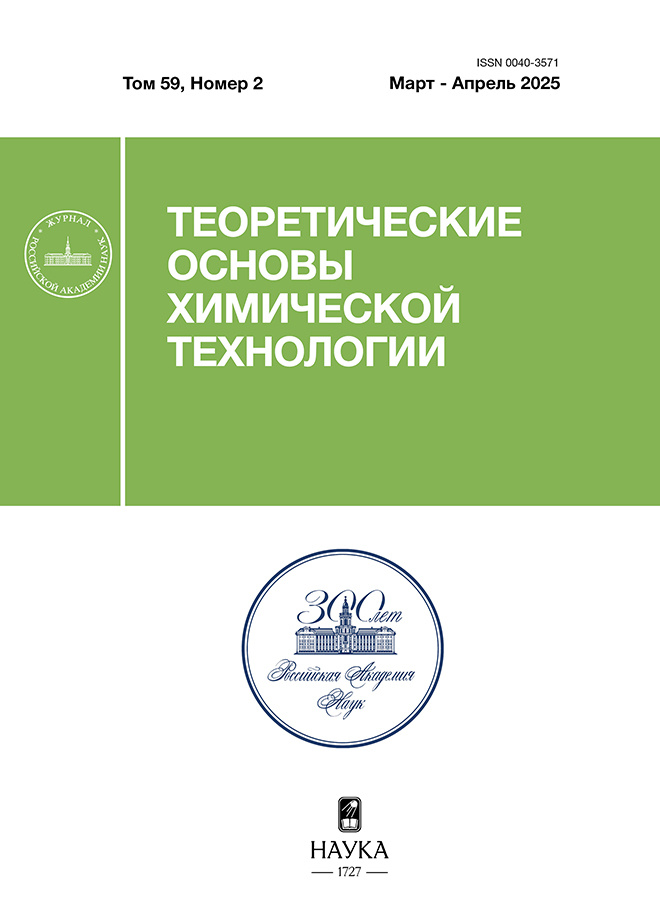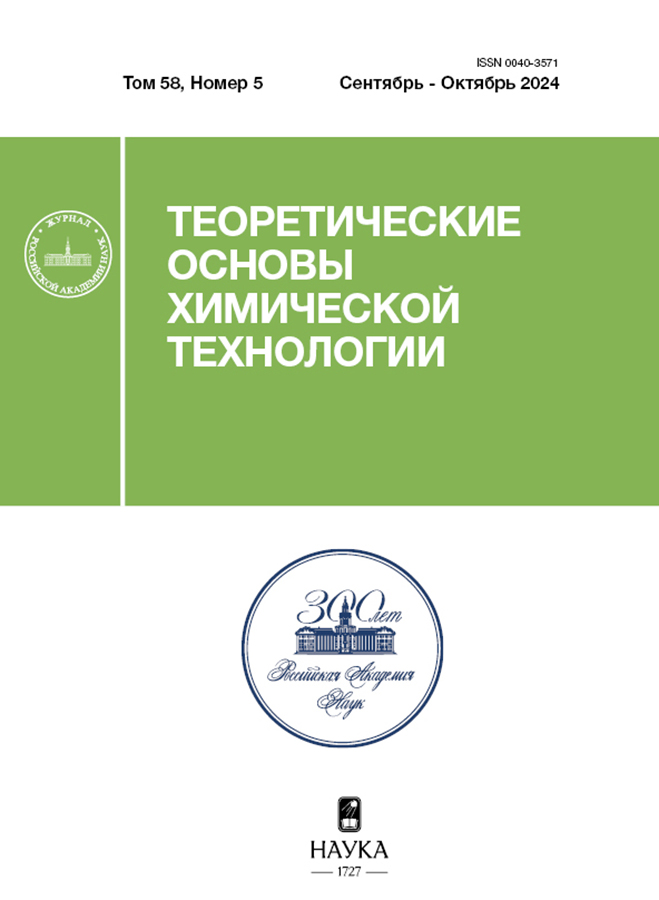Анализ процессов разделения редкоземельных элементов в каскаде смесительно-отстойных экстракторов методами жидкостно-жидкостной хроматографии
- Авторы: Костанян А.Е.1, Лобович Д.В.1, Вошкин А.А.1
-
Учреждения:
- Институт общей и неорганической химии им. Н.С. Курнакова РАН
- Выпуск: Том 58, № 5 (2024)
- Страницы: 533–546
- Раздел: Статьи
- Статья опубликована: 25.09.2024
- URL: https://rjraap.com/0040-3571/article/view/677947
- DOI: https://doi.org/10.31857/S0040357124050015
- EDN: https://elibrary.ru/wdqgtu
- ID: 677947
Цитировать
Полный текст
Аннотация
Для разделения редкоземельных элементов в промышленном масштабе в настоящее время используются методы жидкостной экстракции, обычно реализуемые в сложных многостадийных системах, состоящих из множества смесительно-отстойных экстракторов. Настоящая работа посвящена теоретическому анализу процессов разделения редкоземельных элементов в каскаде смесительно-отстойных экстракторов в режиме жидкостно-жидкостной хроматографии. Благодаря простоте реализуемой схемы и возможности проведения разделения в одной технологической операции, была показана перспективность применения методов жидкостно-жидкостной хроматографии для разделения и выделения из водных растворов концентрированных фракций редкоземельных элементов в каскаде смесительно-отстойных экстракторов.
Полный текст
Об авторах
А. Е. Костанян
Институт общей и неорганической химии им. Н.С. Курнакова РАН
Автор, ответственный за переписку.
Email: kost@igic.ras.ru
Россия, Москва
Д. В. Лобович
Институт общей и неорганической химии им. Н.С. Курнакова РАН
Email: kost@igic.ras.ru
Россия, Москва
А. А. Вошкин
Институт общей и неорганической химии им. Н.С. Курнакова РАН
Email: kost@igic.ras.ru
Россия, Москва
Список литературы
- Xie F., Zhang T.A., Dreisinger D., Doyle F. A critical review on solvent extraction of rare earths from aqueous solutions // Miner. Eng. 2014. V. 56. P. 10.
- Jha M.K., Kumari A., Panda R., Rajesh Kumar J., Yoo K., Lee J.Y. Review on hydrometallurgical recovery of rare earth metals: SI: IC-LGO 2015 // Hydrometallurgy. 2016. V. 165. P. 2.
- Галиева Ж.Н., Абрамов А.М., Соболь Ю.Б., Игумнов М.С., Геря В.О., Шулин С.С., Чижевская С.В. Разработка универсальной технологии и оборудования для разделения редкоземельных концентратов в каскадах центробежных экстракторов, освоение производства // Хим. Пром. Сегодня. 2019. № 3. C. 54.
- Chen L., Wu Y., Dong H., Meng M., Li C., Yan Y., Chen J. An overview on membrane strategies for rare earths extraction and separation // Sep. Purif. Technol. 2018. V. 197. P. 70.
- Banda R., Jeon H.S., Lee M.S. Solvent extraction separation of La from chloride solution containing Pr and Nd with Cyanex 272 // Hydrometallurgy. 2012. V. 121-124. P. 74.
- Kashi E., Habibpour R., Gorzin H., Maleki A. Solvent extraction and separation of light rare earth elements (La, Pr and Nd) in the presence of lactic acid as a complexing agent by Cyanex 272 in kerosene and the effect of citric acid, acetic acid and Titriplex III as auxiliary agents // J. Rare Earths. 2018. V. 36. № 3. P. 317.
- Michelsen O.B., Smutz M. Separation of yttrium, holmium, and erbium with di-(2-ethylhexyl) phosphoric acid in chloride and nitrate systems // J. Inorg. Nucl. Chem. 1971. V. 33. № 1. P. 265.
- Radhika S., Kumar B.N., Kantam M.L., Reddy B.R. Liquid–liquid extraction and separation possibilities of heavy and light rare-earths from phosphoric acid solutions with acidic organophosphorus reagents // Sep. Purif. Technol. 2010. V. 75. № 3. P. 295.
- Zhang F., Wu W., Dai J., Bian X. Extraction and separation of Pr(III)/Ce(III) from chloride medium by 2-ethylhexylphosphonic acid mono-(2-ethylhexyl) ester in the presence of two complexing agents // Sep. Purif. Technol. 2016. V. 51. № 5. P. 778.
- Wang Y., Liao W., Li D. A solvent extraction process with mixture of CA12 and Cyanex272 for the preparation of high purity yttrium oxide from rare earth ores // Sep. Purif. Technol. 2011. V. 82. P. 197.
- Liu Y., Jeon H.S., Lee M.S. Solvent extraction of Pr and Nd from chloride solution by the mixtures of Cyanex 272 and amine extractants // Hydrometallurgy. 2014. V. 150. P. 61.
- Liu Y., Jeon H.S., Lee M.S. Separation of Pr and Nd from La in chloride solution by extraction with a mixture of Cyanex 272 and Alamine 336 // Met. Mater. Int. 2015. V. 21. №. 5. P. 944.
- Chen B., He M., Zhang H., Jiang Z., Hu B. Chromatographic Techniques for Rare Earth Elements Analysis // Phys. Sci. Rev. 2017. V. 2. № 4.
- Chen Z., Li Z., Chen J., Kallem P., Banat F., Qiu H. Recent advances in selective separation technologies of rare earth elements: a review // J. Environ. Chem. Eng. 2022. V. 10. № 1. Article number. 107104.
- Danouche M., Bounaga A., Oulkhir A., Boulif R., Zeroual Y., Benhida R., Lyamlouli K. Advances in bio/chemical approaches for sustainable recycling and recovery of rare earth elements from secondary resources // Sci. Total Environ. 2024. V. 912. Article number. 168811.
- Ignatova S.N., Maryutina T.A., Spivakov B.Ya., Karandashev V.K. Group separation of trace rare-earth elements by countercurrent chromatography for their determination in high-purity calcium chloride // Fresenius J. Anal. Chem. 2001. V. 370. № 8. P. 1109.
- Akiba K. High-speed countercurrent chromatography for separation of americium from lanthanides // J. Radioanal. Nucl. Ch. 2001. V. 249. P. 547.
- Akiba K., Hashimoto H., Tsuyoshi A., Nakamura S. High-speed countercurrent chromatographic purification of middle lanthanoids // J. Liq. Chromatogr. Relat. Technol. 1999. V. 22. № 18. P. 2795.
- Jin Y.-R., Zhang L.-Z., Han S.-J., Zhang L.-X., Zhang J.-M., Zhou G.-Q., Dong H.-B. Behavior of lanthanides in countercurrent chromatography using dihexyl-N,N-diethylcarbamoyl methylene phosphonate as stationary phase // J. Chromatogr. A. 2000. V. 888. № 1. P. 137.
- Ma Z., Zhang L., Han S. Separation of samarium, gadolinium, terbium, gysprosium, erbium and ytterbium by high-speed countercurrent chromatography with organophosphate ester // J. Chromatogr. A. 1997. V. 766. № 1. P. 282.
- Nakamura S., Hashimoto H., Akiba K., Saito Y. Mutual Separation of Heavy Lanthanoid Elements and Yttrium by High-Speed Countercurrent Chromatography // Anal. Sci. 1997. V. 13. № 4. P. 525.
- Dembowski M., Rowley J.E., Boland K., Droessler J., Hathcoat D.A., Marchi A., Goff G.S., May I. Rare earth element separations by high-speed counter-current chromatography // J. Chromatogr. A. 2022. V. 1682. Article number. 463528.
- Friesen J.B., McAlpine J.B., Chen S.-N., Pauli G.F. The 9th International Countercurrent Chromatography Conference held at Dominican University. Chicago. USA. August 1–3. 2016 // J. Chromatogr. A. 2017. V. 1520. P. 1.
- Ignatova S., Sutherland I. The 8th International Conference on Counter-current Chromatography held at Brunel University, London, UK, July 23–25, 2014 // J. Chromatogr. A. 2015. V. 1425. P. 1.
- Conway W.D. Counter-current chromatography: Simple process and confusing terminology: Selected Papers from the 6th International Conference on Countercurrent Chromatography // J. Chromatogr. A. 2011. V. 1218. № 36. P. 6015.
- Morley R., Minceva M. Operating mode and parameter selection in liquid–liquid chromatography // J. Chromatogr. A. 2020. V. 1617. Article number. 460479.
- Ito Y. Golden rules and pitfalls in selecting optimum conditions for high-speed counter-current chromatography // J. Chromatogr. A. 2005. V. 1065. № 2. P. 145.
- Guilois-Dubois S., Guyot S., Poupard P. Preparative isolation of apple flavan-3-ols monomers and oligomers using pH-zone-refining centrifugal partition chromatography combined with reversed-phase liquid chromatography // J. Chromatogr. A. 2021. V. 1653. Article number. 462382.
- Li H., Zhang F., Jin Q., Zhu T. Preparative separation and purification of Cyclosporin D from fungus Hypoxylon Spp. by improved closed-loop recycling counter-current chromatography // J. Chromatogr. A. 2021. V. 1649. Article number. 462221.
- Oka H., Iwaya M., Harada K., Suzuki M., Ito Y. Recycling Foam Countercurrent Chromatography // Anal. Chem. 2000. V. 72. № 7. P. 1490.
- Quiñones I., Grill C.M., Miller L., Guiochon G. Modeling of separations by closed-loop steady-state recycling chromatography of a racemic pharmaceutical intermediate // J. Chromatogr. A. 2000. V. 867. № 1. P. 1.
- Han Q.B., Song J.Z., Qiao C.F., Wong L., Xu H.X. Preparative separation of gambogic acid and its C-2 epimer using recycling high-speed counter-current chromatography // J. Chromatogr. A. 2006. V. 1127. № 1. P. 298.
- Xie J., Deng J., Tan F., Su J. Separation and purification of echinacoside from Penstemon barbatus (Can.) Roth by recycling high-speed counter-current chromatography // J. Chromatogr. B. 2010. V. 878. № 28. P. 2665.
- Nagai T., Mizobe H., Otake I., Ichioka K., Kojima K., Matsumoto Y., Gotoh N., Kuroda I., Wada S. Enantiomeric separation of asymmetric triacylglycerol by recycle high-performance liquid chromatography with chiral column // J. Chromatogr. A. 2011. V. 1218. № 20. P. 2880.
- Tong S., Guan Y.-X., Yan J., Zheng B., Zhao L. Enantiomeric separation of (R, S)-naproxen by recycling high speed counter-current chromatography with hydroxypropyl-β-cyclodextrin as chiral selector // J. Chromatogr. A. 2011. V. 1218. № 32. P. 5434.
- He J.-M., Huang J., Wu W.-L., Mu Q. Unlimited recycling counter-current chromatography for the preparative separation of natural products: Naphthaquinones as examples // J. Chromatogr. A. 2020. V. 1626. Article number. 462221.
- Peng A., Hewitson P., Sutherland I., Chen L., Ignatova S. How changes in column geometry and packing ratio can increase sample load and throughput by a factor of fifty in Counter-Current Chromatography // J. Chromatogr. A. 2018. V. 1580. P. 120.
- Roehrer S., Minceva M. Evaluation of Inter-Apparatus Separation Method Transferability in Countercurrent Chromatography and Centrifugal Partition Chromatography // Separations. 2019. V. 6. № 3. P. 36.
- Kostanyan A.E., Voshkin A.A., Kodin N.V. Controlled-cycle pulsed liquid–liquid chromatography. A modified version of Craig’s counter-current distribution: Selected Papers from the 6th International Conference on Countercurrent Chromatography // J. Chromatogr. A. 2011. V. 1218. № 36. P. 6135.
- Kostanyan A.E., Belova V.V., Tsareva Y.V., Petyaeva M.M. Separation of Rare Earth Elements in Multistage Extraction Columns in Chromatography Mode: Experimental Study and Mathematical Simulation // Processes. 2023. V. 11. №. 6. P. 1757.
- Костанян А.Е., Царева Ю.В., Белова В.В. Выделение из растворов концентрированных фракций компонентов в каскаде многоступенчатых экстракционных колонн методами рециркуляционной жидкостно-жидкостной хроматографии // Журн. неорган. химии. 2023. Т. 68. № 3. С. 357.
- Костанян А.Е. Экстракционно-хроматографическое разделение редкоземельных металлов в каскаде центробежных экстракторов // Журн. неорган. химии. 2017. V. 62. № 12. P. 1666.
- Костанян А.Е., Милевский Н.А., Вошкин А.А. Анализ процессов экстракционно-хроматографического разделения в каскаде смесительно-отстойных экстракторов // Теорет. основы хим. технологии. 2021. Т. 55. N 5. C. 559.
- Kostanyan A.E., Erastov A.A. Industrial countercurrent chromatography separations based on a cascade of centrifugal mixer-settler extractors // J. Chromatogr. A. 2018. V. 1572. P. 212.
- Kostanyan A.E., Galieva Z.N., Semenov A.A., Aldushkin A.V. Chromatographic behavior of six lanthanides on a centrifugal mixer-settler extractor cascade // J. Chromatogr. A. 2020. V. 1634. Article number. 461686.
- Afonin M.A., Nechaev A.V., Yakimenko I.A., Belova V.V. Extraction of Rare Earth Elements from Chloride Solutions Using Mixtures of P507 and Cyanex 272 // Compounds. 2024. V. 4. № 1. P. 172.
- Kostanyan A., Martynova M. Modeling of two semi-continuous methods in liquid–liquid chromatography: Comparing conventional and closed-loop recycling modes // J. Chromatogr. A. 2020. V. 1614. Article number. 460735.
- Kostanyan A.A., Voshkin A.A., Belova V.V. Analytical, Preparative, and Industrial-Scale Separation of Substances by Methods of Countercurrent Liquid-Liquid Chromatography // Molecules. 2020. V. 25. № 24. Article number. 6020.
- Kostanyan A.E., Voshkin A.A. Modeling of analytical, preparative and industrial scale counter-current chromatography separations // Journal of Chromatography A. 2024. Т. 1713. Article number. 464534.
- Kostanyan A.E. A simple and highly efficient counter-current chromatography method for the isolation of concentrated fractions of compounds based on the sequential sample loading technique: Comparative theoretical study of conventional multiple and intermittent sample loading counter-current chromatography separations // J. Chromatogr. A. 2021. V. 1647. Article number. 462163.
Дополнительные файлы



















